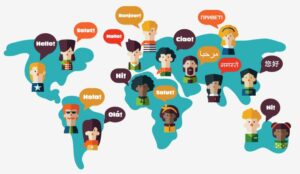Today’s consumers want brands to speak to them in their own language. Almost seven in ten (68%) consumers would switch to a different brand if it offered support in their native language, according to research for Unbabel.
And 64% would pay a higher price for a product or service where support was available in their own language.
The challenge for brands is how to provide this native-language support when their customers span many countries and languages. As well as being expensive to run customer management operations in multiple geographies, it can weaken the brand by delivering inconsistent customer experiences.
Hubs Could Be the Answer – When They’re Done Right
The solution is multilingual hubs. Rather than manage a complex network of customer management operations across different countries, brands can:
- provide standardized and efficient processes from a centralized hub, while catering for different languages and local behaviors
- gain significant cost reductions and economies of scale from shared management team structures and IT assets
- deliver a consistent CX across different geographies
- operate in a single regulatory environment.
- offer native-language support to markets where volumes would not be large enough for stand-alone contact centres
- enjoy the benefits of a diverse working environment where staff can learn from different cultures and approaches.
When you put it like that, multilingual hubs sound like a no-brainer. But in order to deliver those benefits, hub providers must be on top of the challenges around location, culture, people, process design and technology.
There’s No One Size – or Place – That Fits All
There’s no single perfect location for a multilingual hub. Different geographies tend to offer different benefits, including language mix, cultural affinities, costs, and levels of technical expertise.
It’s why Comdata operates nine multilingual hubs in locations as far afield as Barcelona and Malaga, Bucharest, Casablanca, Paris, London, Istanbul, Mexico City and Bogota, serving more than 30 languages.
According to Pedro Rodríguez, Chief Commercial Officer for Comdata Spain and Latam, “We know that having multilingual operations in different locations is key to being able to accommodate the needs of each client and offer them the most effective solutions.”
Location Choices Are Not Always Obvious
“Before suggesting the best location or locations for a client, we focus on really understanding their needs,” explains Monica Butea, Director of Operations – Romania Global Clients Division at Comdata. “The first step is understanding which market contributes to the majority of the volume.”
She gives an example. For a brand where Spanish-speaking customers make up a large part of volumes, it would be natural to look at Comdata’s hubs in Malaga or Barcelona.
But if the client wanted support for Eastern European languages as well as Spanish, a good alternative might be Bucharest. Or if they wanted Nordic or Asia Pacific languages as well, London could offer that.
In some cases, Comdata would suggest one main delivery site but offer some languages from a satellite second location. Thus, on one account, the multilingual team in Bucharest partners with Comdata Czech for Czech and Polish customers.
For another client, SodaStream, Comdata’s London hub provides multilingual customer care in France, the UK, North America, Benelux, Poland and South Africa, while a team in Istanbul supports Germany and Austria.
Other factors affecting the choice of location will include cost and the different levels of technology expertise or sector specialization required by the brand.
To Offer Choice, Providers Must Ace Their Own Choices
When knitting together a network of multilingual hubs, a provider like Comdata must make its own choices around location and complementarity.
Priority number one is language sourcing ability. You want access to talented, committed, tech-savvy staff who can provide the languages and cultural affinities required. Usually this means locating in places with a good ecosystem of universities, colleges and/or language schools.
Other factors will include:
- labor and real estate costs.
- local contact center regulations
- transport and communications infrastructure, offering good access not just for the workforce but for the client
- a business ecosystem that draws talent to the area and offers scalability
- attractive cost of living and lifestyle to help attract and retain staff.
“If you don’t do it right, the challenges will flower”
There was a time a few years back when low-cost, high-volume multilingual hubs seemed like the answer to everything. You put a bunch of languages and nationalities in the room, and, hey presto, the client’s multi-country needs are sorted.
But it’s more complicated than that. Providers need to expertly deal with multiple challenges around managing customer needs, people, and compliance.
Customer Needs: Language Ability Is Just the Start
Building trust and empathy with customers requires more than simply speaking their language. “We make sure we understand really well the customers’ needs and expectations from the product or service we support. Then we tailor our training content to the specificities – not just language – of each market,” says Monica Butea.
These specificities will include variations in channel preference and average handling times across different markets and cultures. For instance, data from Comdata’s Bucharest hub shows that:
- one-third (33%) of German customers prefer to contact the brand via email, compared to less than one-fifth (19%) in Italy.
- average handing times for Italian and Spanish calls are between 90 seconds and 2 minutes longer than a call coming in from Germany and Austria.
KPIs and service level agreements (SLAs) must reflect this, and brands and providers need to establish a fair and transparent benchmarking system between markets.
People and Regulatory Issues Are Also Key
A second key challenge with multilingual hubs is HR and people management, and the critical need to establish a diverse and inclusive workplace.
“The main challenge is to create that vibrant, international, inclusive working environment where everybody fits in, collaborates, takes part in decision-making, has fun, and thrives,” suggests Pedro Rodríguez. Without that, attrition rates can be high, and service to customers diminished.
Regulatory and legislative compliance is a third major challenge, given the need to comply not only in the market where the hub is located, but in the different markets the hub serves.
Emerging Technologies Will Reconfigure the Landscape
Digital transformation affects every aspect of customer management, but there are specific technologies of particular relevance for offering multilingual CX. One such is real-time translation and analytics tools, enabling brands and providers to convert real-time text or voice into data, and do real-time analysis.
“Brands have millions of touchpoints with their customers, but the data has no value if you don’t know what to do with it. They need providers who have the tools to do this, to segment the data, store it and use it …
“Having real-time translation and speech and text analytics tools can help us understand not just what’s happened before, but what’s happening now and what’s going to happen in the future,” advises Pedro Rodríguez.
For Monica Butea, emerging translation technologies are also changing the economics for brands. She gives the example of translation chat and email bots that can help deflect some of the volume for easily resolved and known issues or for very low-volume products. “These can help ensure native support in areas where companies would not be willing or able to invest in resources.”
Brands in all geographies need providers with capabilities in these emerging technologies around speech/text translation and data analysis, and the ability to maximize the opportunities and benefits.
Brands Need Providers Who Can Deal With the Speed of Change
Digital transformation is not the only trend shaping the future of multilingual hubs. Also coming down the track are other trends, presenting both challenges and opportunities for brands and providers:
- The shift to remote and hybrid working patterns will increase the talent pool but also present new HR challenges. The most successful multilingual hub providers will be those who successfully blend in-person team building and training with remote working options that suit people’s lifestyles.
- The need for digital expertise and skilled employees will accelerate a switch from high-volume megahubs to more specialized mid-sized boutique hubs. These will need to combine automation tools for repetitive tasks with the capabilities to manage escalations and value-added interactions, in order to provide the omnichannel, personalized support that customers now expect.
These are big shifts, and not all customer management providers are ready to make them. More than ever, brands need support from customer-centric providers who are agile enough and lean enough to deal with change.
Author: Guest Author
Published On: 2nd Dec 2021 - Last modified: 7th Dec 2021
Read more about - Guest Blogs, Comdata





































